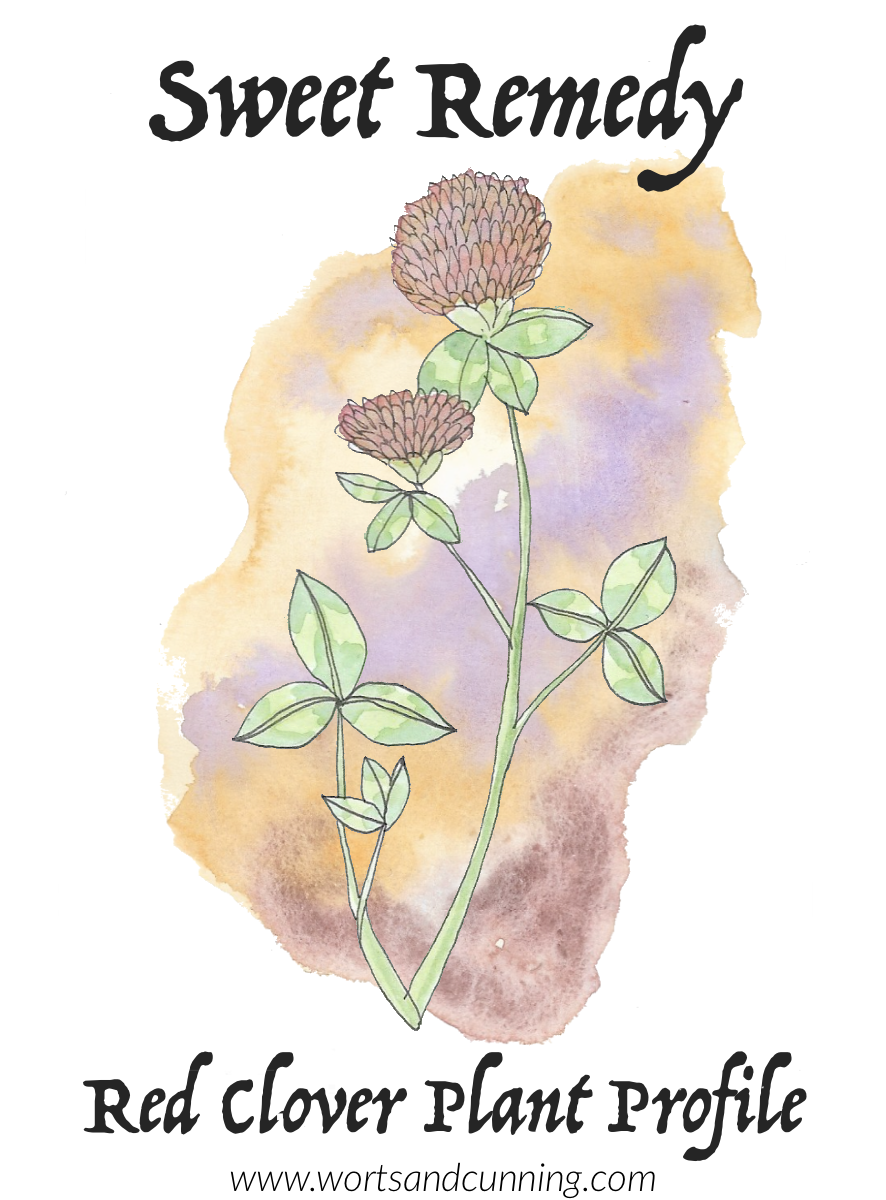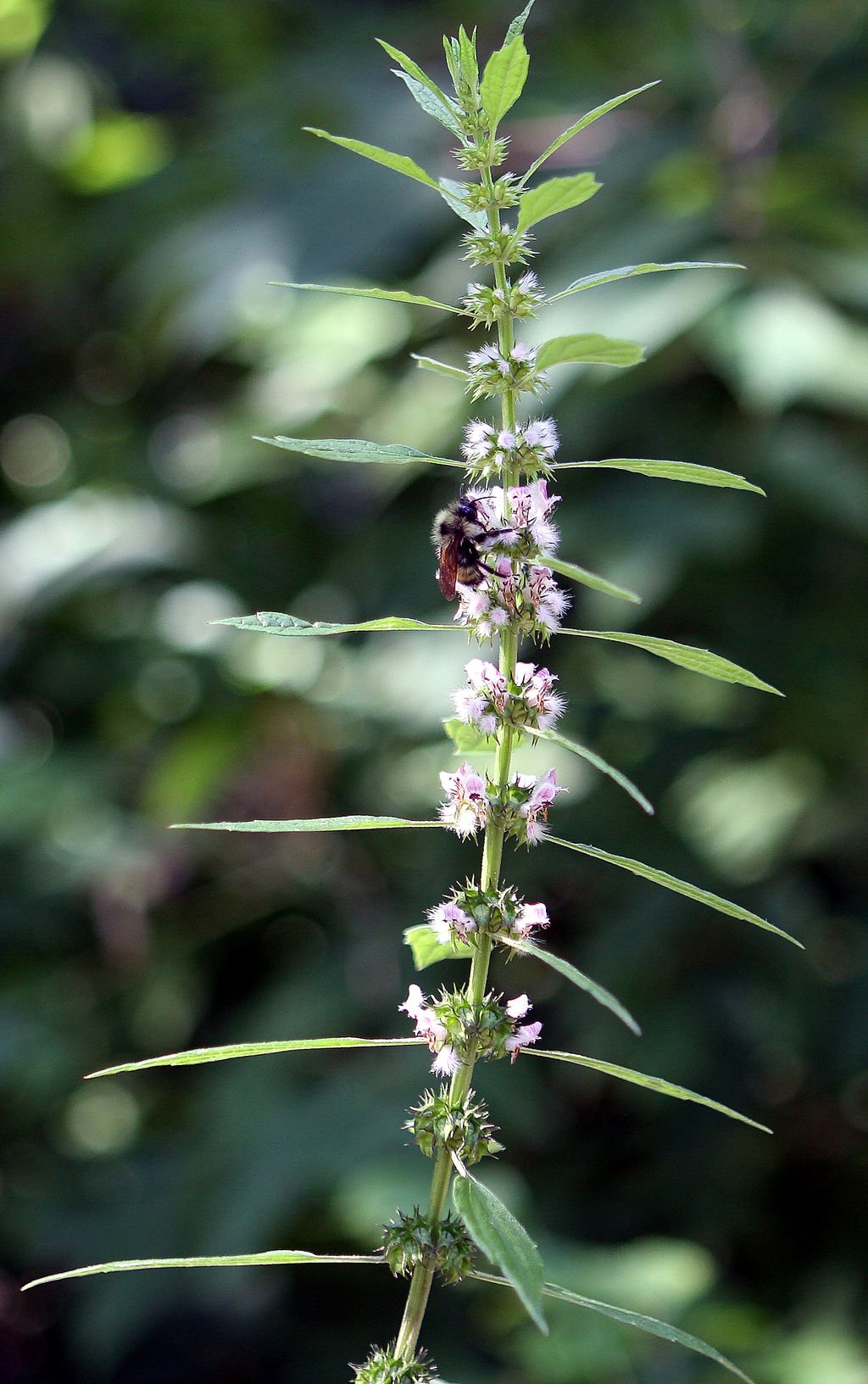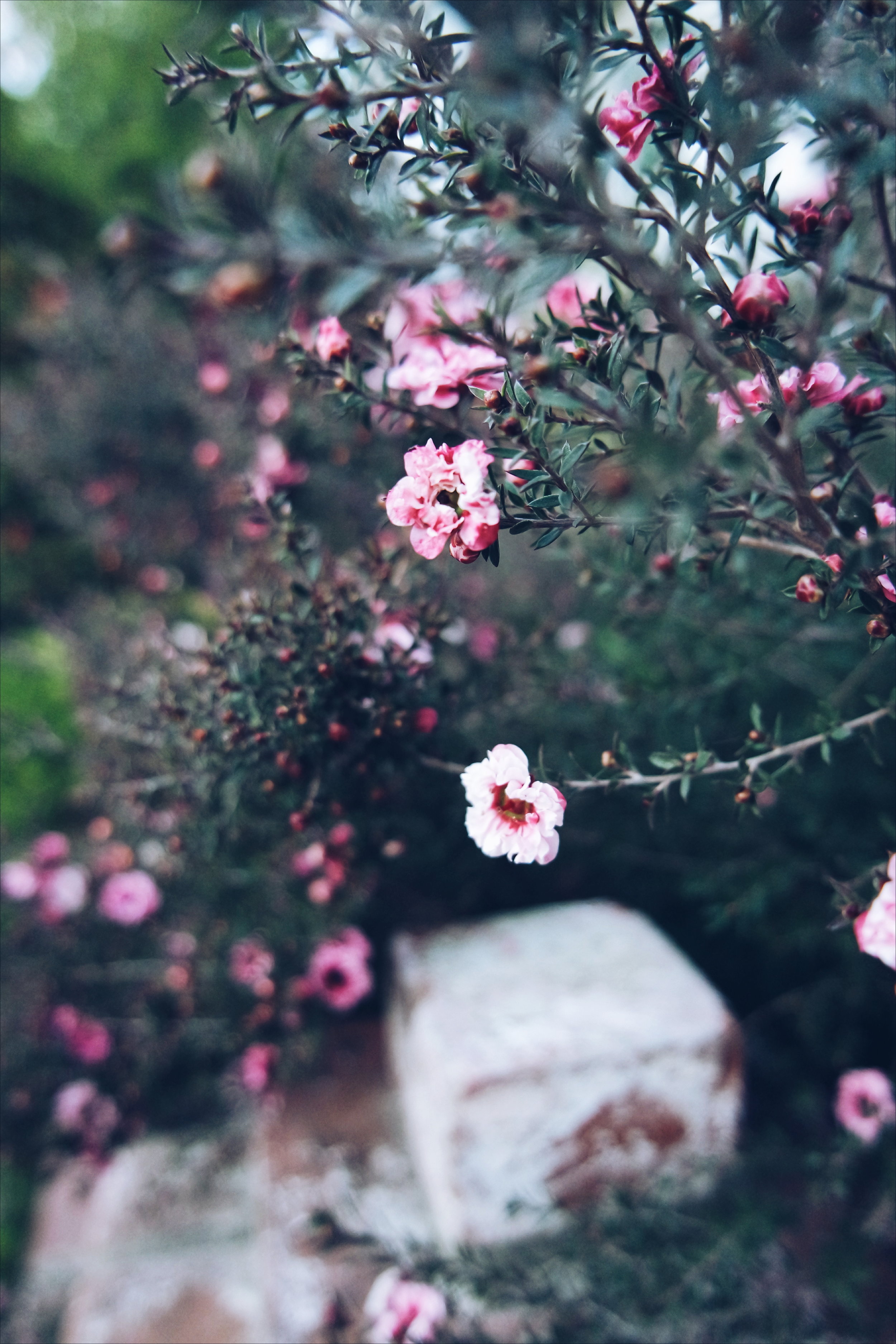Sweet Remedy: Red Clover Plant Profile
I’m so happy to be writing about a plant that I grew up with and spent many a happy hour as a child creating crowns with. A field of Red Clover (Trifolium pratense) is a sight that fills me with happiness and I hope to share with you some of the ways that this common flower can be used in your herbal practice. You can find a printable version of the guide below in The Plant Ally Library.
So what does a flower associated with luck and the Good Folk have to offer when it comes to healing? Let’s learn!
Red Clover
(Trifolium pratense)
Common + Folk Names : Sweet clover, bee bread, cow clover, honeystalks, marl grass, peavine clover, meadow honeysuckle, meadow trefoil, purple clover, three-leaves grass, trefoil, trifoil, trébol, cloeferwort.
Tarot Cards : The Suit of Cups, the Star (learn more about the connections between the tarot and herbs)
Element : All Elements
Zodiac Signs : Cancer (Guardian)
Planets : Venus, Moon, Mercury
Moon Phase : New Moon
Parts used : Flower and leaf
Habitat : Native to Eurasia, North Africa, and North America, and widely naturalized in grassy areas and roadsides.
Growing conditions : Full to partial sun with moderate water.
Collection : Collect in spring and avoid collection in autumn due to issues with toxic mold.
Flavor : Sweet
Temperature : Cool
Moisture : Moist
Tissue State : Dryness (Atrophy), Tension (Constriction) - learn more about traditional western herbalism energetics.
Constituents : Protein, beta-carotene, B-complex vitamins, vitamin C, chromium, copper, iron, magnesium, manganese, selenium, silicon, flavonoids, phenolic glycosides, volatile oils, polysaccharides, isoflavones, salicylates, coumarins, cyanogenic glycosides.
Actions : Alterative, antibacterial, anti-inflammatory, antispasmodic, antiseptic, antispasmodic, antineoplastic, antitumor, antitussive, aperient, blood thinning, cardiotonic, deobstruent, depurative, diuretic, expectorant, galactagogue, laxative, nutritive, phytoestrogenic, sedative, vulnerary.
Main Uses : When I ask folks in my classes about early experiences with plants, one of the common memories mentioned is making crowns out of Clover blossoms, myself included. I grew up listening to stories of the Good Folk and woodland creatures savoring the sweetness of Clover and made plenty of Clover crowns (and necklaces and bracelets) as part of my childhood adventures. I've yet to live anywhere that I haven't spotted a variety of Clover growing in an open field or roadside and I find myself drawn to the blooms again and again whenever I have a chance to spend time in stillness out in a park or grassy area.
Before I started my formal herbal studies I knew of Red Clover's magickal qualities (more on that below) and learned about its value as a nutrient rich cover crop through my permaculture studies. It wasn't until I was a few years into my practice as an herbalist that I began to really appreciate the healing qualities of Red Clover when looking for herbs to support fertility. Since then, Red Clover has become one of my most trusted and reliable herbal support for folks hoping to conceive. The herb has a number of qualities which makes it so useful to supporting fertility including having an estrogenic effect on the internal reproductive organs which can be helpful in many ways including having a positive influence on ovulation. Red Clover can also be used for improving sperm count. I feel like Red Clover also helps with conception because it is nutrient rich, helps reduce stress, and assists with cleansing out energetic congestion.
In addition to clearing out energetic congestion, Red Clover has a prized place in traditional western herbalism as a blood cleanser, helping to clear conditions of toxicity, and supporting the elimination of toxins from the body as a diuretic. Red Clover has an affinity for the blood and can be used for a variety of chronic blood conditions including anemia. Famed Appalachian herbalist Tommie Bass used Red and White Clover as a blood building tonic and it's an easy herb to add to your spring tonic blends to rebuild energy and the immune system after a long winter. The herb also supports the lymphatic system and helps to expel excess phlegm through its quality of thinning out and expulsion. A stiff neck that improves with heat is one of the indicators that Red Clover might be a useful and needed ally.
I really like Red Clover for menstrual cycles that are heavy and painful. Start using the herb as a tea a week before the menstrual cycle begins and then throughout the cycle - do this for a few months for best results. You can consider combining Red Clover with uterine tonic Raspberry Leaf (Rubus idaeus) especially where cramps are overpowering. Crampbark (Viburnum opulus) or Black Haw (Viburnum prunifolium) can be used as needed for cramps, too. Red Clover is also a useful ally for menopause, helping to reduce uncomfortable symptoms like hot flashes, night sweats, and general irritability. The herb can be used as a tea and douche for vaginal infections.
In cases of coughs and congestion, Red Clover can be used to break up phlegm, soothe coughs, and clear bronchial passages. The herbs antiviral and anti-inflammatory qualities help to prevent the cold and flu from settling into the body. Use in post-cold blends and for recovery from fatigue-based diseases as a nutritive tonic and to help rebuild strength - especially wonderful in foot baths post-recovery to improve circulation and cleansing the lymph system. Red Clover has traditionally been used to treat hard swellings, cysts, nodules, and persistent inflammation in the body, including cancerous swellings and infections, especially of the lymphs, breasts, and ovaries.
Red Clover is a wonderful skin ally, addressing issues of acne, eczema, psoriasis, and general skin inflammation. A lovely ally for teenagers as a tea and skin wash for acne. Use as a wash, bath, and/or salve for old skin wounds that are slow to heal and a hair rinse for an irritated scalp. A good choice for athlete's foot, all sorts of bites and stings (Culpeper notes its use as a remedy against adder bite), arthritic pain, burns, and general wound care. Herbalists Jalue Bruton-Seal and Matthew Seal recommend combining equal parts of Red Clover with Curly Dock (Rumex crispus) in tincture form for chronic constipation, general toxicity, acne (or other inflamed skin conditions, and swollen glands. Use as an eyewash for conjunctivitis and a gargle for sore throats.
Magickal Uses : Red Clover is primarily a plant of luck and good fortune, helping to protect against baneful forces. Use the herb in all spells of luck and abundance. A four leaf clover is a lucky charm, especially if you found it yourself. Scott Cunningham has advice for each variety of leafed Clover:
"Two-leaved: If you find a two-leaved clover, you shall soon find a lover. Three-leaved: Trefoil, or three leaved clover, is worn as a protective amulet. Four-leaved: The four-leaved clover, if worn, helps men avoid military service. It also protects against madness, strengthens psychic powers, enables you to detect the presence of spirits, and leads the wearer to gold, money, or treasures. If two people eat a four-leaved clover, mutual love will result. Seven grains of wheat laid on a four-leaved clover will enable one to see fairies. If you put a four-leaved clover in your shoe before going out you will increase your chances of meeting a new love. Five-leaved: The five-leaved clover is powerful for attracting money, and should be worn for this purpose."⁴
With its strong association with the Good Folk, you can incorporate Red Clover (and all varieties of Clover) into rituals and magick involving Them. Red Clover is also a lucky charm to keep on you for cultivating fortuitous chance encounters. You can set the intention for this by writing down the type of encounter you're seeking (i.e. I want to meet someone who will help me get the job of my dreams) and folding the paper around a Clover leaf and blossom.
The Red Clover Personality : Red Clover folk can have the appearance of energetic and physical weakness due to feeling overwhelmed by the world around them. In other words, they are in the midst of a storm and are losing a sense of their center and who they are. There have been repeated experiences in their life that have led them to feeling unsteady in their sense of self which can further compromise an already inherently sensitive disposition. While not a strict rule, I would say that most Red Clover folk I've met would qualify as highly sensitive people. The lack of support and trust in their sensitivity often has been taught to them by caretakers, peers, and other people they are in significant relationship with, and they then proceed to perpetuate their own self-restricting cycles of denying, being frustrating with, and/or worn down by their sensitivity.
While there are many plant allies for sensitive folks, Red Clover folk seem to have a particular signature of denying their psychic and intuitive gifts which leads to a state of listlessness and an energetic cloudiness or congestion that feels impossible to clear. There might even be a fear of their own psychic gifts, sometimes stemming, in part, from frightening psychic experiences in their childhood. One of the beautiful paths of healing that Red Clover folk can take is to cultivate their psychic gifts while simultaneously connecting with the spirit of the Land they live with as well as ancestral Lands. Red Clover can help them to feel strengthened and grounded in their sensitivity through this approach of Land-centered intuitive practice so that they can flourish in their many ways of experiencing the world.
Contraindications : Avoid with blood thinner medication or if you have a bleeding disorder. Avoid at least a week before surgery. Avoid altogether or use only in pregnancy and breastfeeding in small doses with guidance from an herbal practitioner.
Drug interactions : Caution with anticoagulants, salicylates, and Warfarin.
Dosage : Standard dosage.
🌿
If you’ve connected to the story of Red Clover as an ally for folks with heightened sensitivity, check out my other recommendations for highly sensitive folk. You might find plant allies like Chamomile (Matricaria recutita) useful, too.
I hope you find a lot of joy and play working with Red Clover!
This post was made possible through patron support.
❤︎ Thanks, friends. ❤︎
📚
Footnotes
1. Rebecca Beyer, Mountain Magic: Explore the Secrets of Old Time Witchcraft (New York, NY: Wellfleet Press, 2023), 51.
2. Nicholas Culpeper, and J. J. Pursell, Culpeper's Complete Herbal: A Compendium of Herbs and Their Uses, Annotated for Modern Herbalists, Healers, and Witches (Portland, OR: Microcosm Publishing, 2022), 89.
3. Julie Bruton-Seal and Matthew Seal, Backyard Medicine: Harvest and Make Your Own Herbal Remedies (New York: Castle Books, 2012), 141.
4. Scott Cunningham, Cunningham's Encyclopedia of Magical Herbs (St. Paul, MN: Llewellyn, 2001), 87.






























